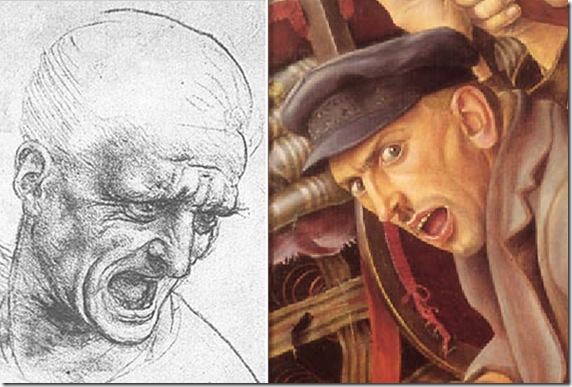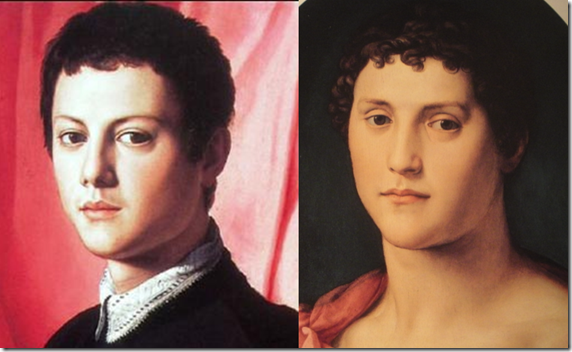Ruhrkampf, Part 2
Who knew going back to school would be so complicated…seems I have to provide proof of immunizations before I can go, which I’ll be taking care of today – it’s funny the little things that would never occur to you as being necessary, the things nobody ever talks about because they’re so dull or minute I suppose. People talk about going “back to school” and it’s all high-flown and high-minded, but you never hear about the wrench a little thing like that can throw into the works. For a minute, it looked dodgy whether I could get the requisite paperwork in time – of all the things to stop me now! But the doctor’s office is handling it and all is well.
A few more notes on the Gilles painting, and then tomorrow a status report on the Bronzino book’s next chapter, which I’m almost ready to write (thanks to the help of a reader in Italy who provided me with some wonderful translations of links she found through google.it).
As I’ve said, I’m still lacking in vocabulary to discuss this painting as completely as I’d like, but I’ve noticed a few more things I wanted to point out.
The POV is defensive, placed within only enough space to hold three men, and the look of urgency, terror and resolve all at once on the first fighter’s face shatter the “fourth wall” – you are not a bystander in this battle, Gilles is saying.
The barricades are made of the materials from their homes: broken-down and dirty old box springs, chipped chairs, what looks like an old basket (the woven piece, I can’t identify it) and of course tightly bundled stacks of newspapers, since the fighters are educated (undoubtedly at the time self-educated) workingmen, well aware of what they are fighting for. More bundled newspapers sit behind the ammunition box – a political comment: “When your bullets tear apart our first batch of words, there are more where those come from.”
The background of the scene is stark and utilitarian, a pair of modern buildings (which some thoughtless architect has built, it appears, without windows that open), as opposed to the lavish Roman/Imperial piles in the backgrounds of classical painting.
The attention to detail given to the clothes, which I mentioned yesterday, is a commentary on the care given in painting to the garments of the rich, since here it’s given a small ironic twist – Gilles subtly includes a patch on the well-worn pants of the first man.
There’s what looks like a bullet hole in the cap of the top man – deliberately angled by the artist so it appears that it just missed his skull by a fraction.
The traditional battle scene is a panorama, encompassing the victors, the vanquished, and any other symbolic elements necessary to drive the point home. But the battle scene in Ruhrkampf is small and claustrophobic, as is appropriate for the point of view, that of the soldier on the ground rather than that of the General, Duke or Emperor. The only claustrophobic classic war piece I can think if is da Vinci’s “lost” painting, Battle of Anghiari, and I think I see a “reference” in the face of the bottom man in Ruhrkampf to a face in one of da Vinci’s sketches for Anghiari:
I’m sure that somewhere out there, art historians are using 3D or facial recognition software of some kind to confirm their hunches about whether or not a “reference” is being used as they think it is – a sort of “12 point match” system for faces and body positions in artworks. If not, well, someone should get cracking. Myself, I can’t help but see the resemblance between two Bronzino paintings, one definitively identified as Pierino da Vinci and another whom Brock calls a “young man, of whom we know nothing”:
The unknown figure, to me, looks like a slightly older, “matured” version of the youth in the left hand picture. The angle and lighting are different, but the nose and lips appear to be a match, as does the the oval of the face. The eyebrows are similar, the bridge between them is slightly wider in the second pic, but that could be explained by the angle of the gaze. Pierino died young – aged 24 in 1553; the “unknown” pic is dated to 1545 when he was only 16, but then date attributions have been wrong before. The “known” pic is dated “1550s,” and may have been a tribute to the promise of youth after Pierino’s death – in which case, it’s possible that the known portrait was reverse-engineered from the “unknown” one.
Just guessing, but my goodness I love this stuff.


I was glad to help you. I have a collection of volumes, it’s very old, and out of print, dated back to ’50 and ’60. Each volume is about the story of a family, and there is one about de Medici. Yesterday night I re-read the chapter about Cosimo I and Bronzino is named more than once. In a sentence it’s also said that Vasari and he helped Cosimo I to rebuild an art collection that was stolen during an invasion years before. It was an interesting sentence to understand that a court painter was not only a old type of photographer, but sometime he could be also a trusted friend.
I just read Christopher Hibbert’s history of the Medicis, and it was interesting how they treated artists – Cosimo (the first) and Lorenzo the Magnificent weren’t only patrons of the arts but indulged their artists’ sometimes odd ways; I think it was Lorenzo who said artists were not to be treated like other servants and workmen, but as a “step above.” They were very friendly towards their artists as well, though it seems from this book that Cosimo I de Medici could run hot and cold – sometimes intimate and affectionate but other times quite lordly and cold. Still, this Medici history of closeness with artists gives me an opening to make Cosimo more of a figure in the plot than he might have been otherwise.
Do you read Italian? If you want I can scan you the chapter about Cosimo I de Medici. The book is out of print and it’s part of a collection (I have 32 volume out of 33, I so want to find that last book) so I cannot send you the book itself, and for me translate the entire chapter is too much. But if you want, I can send you, no biggie.
Elisa
I don’t, but yes, I’d love to have it, if it’s no trouble – I can find a student here to translate it for me. Please send to ooutland (don’t want to put the link in and get it harvested by spambots) at gmail. Thanks!